Nemesis
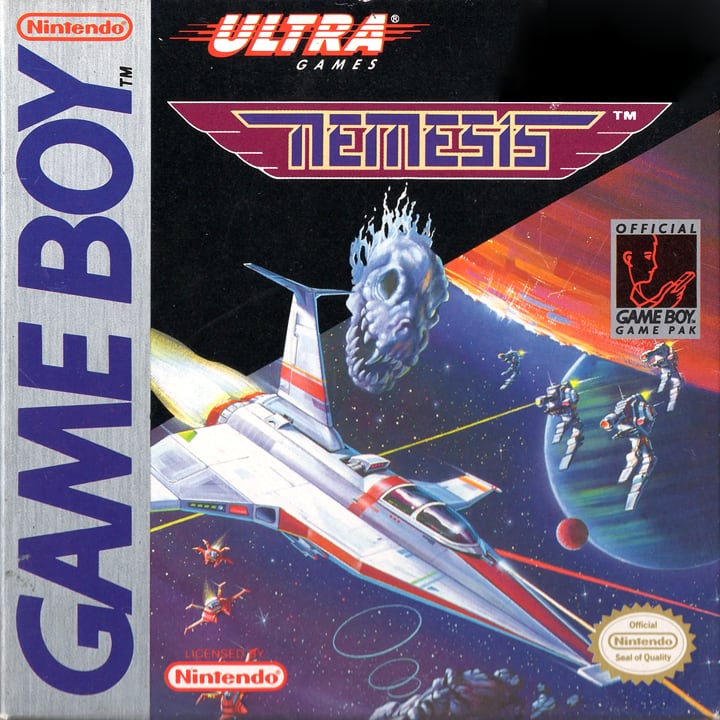
- Japanese release in February 1990
- North American release in April 1990
- European release in 1991
- Developed by Konami
Mastery at an Early Age

Nemesis is surprising. It is rough around the edges in some places but it is a great game that came out way too early in time in the Game Boy’s life for this level of mastery. It has amenities that have the peculiarities of the Game Boy in mind while keeping intact the feeling you have when you play Gradius or Life Force (Salamander in Japan) on NES. They did all that very early, managing to make a game that feels like a 1992 Game Boy title, when the game actually came out in 1990.
The Right Little Stuff
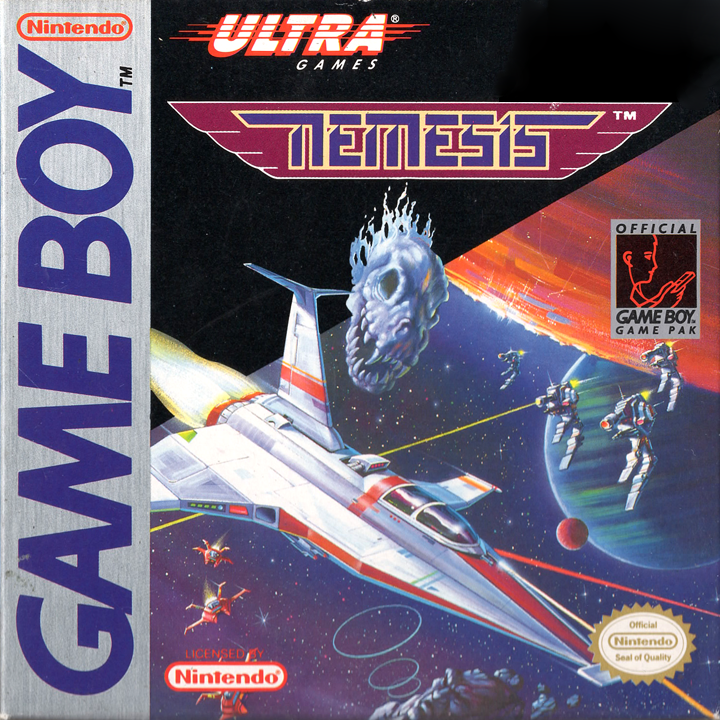
I think the good people at Konami figured out quickly what was achievable on the system. The company first published Motocross Maniacs (another essential title) and applied the same principles as that game with Nemesis. Non-coloured backgrounds are a staple of both games, allowing you to have a better grasp of the action on the original DMG’s green screen. Another conceit is reasonably sized sprites.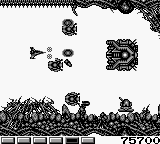 Here’s Nemesis over Gradius to show that even though Nemesis has relatively bigger ships, they’re not too big. You still have a good amount of space to move in.
Here’s Nemesis over Gradius to show that even though Nemesis has relatively bigger ships, they’re not too big. You still have a good amount of space to move in.
They made the main characters of both titles (a motocross and a spaceship) small enough to give you a reasonable play field but not so small as to recreate the size of the play field you would see on NES. This is different from what Super Mario Land did with its very close recreation of the Super Mario Bros. play field. The most interesting amenity to adapt their concept is definitely the game select screen. I can only describe it as a debug menu that they decided to keep in. It’s like the Konami Code without having to put it in, but better. Still using the Konami code while playing will give you all the options, just like in Gradius.
It’s like the Konami Code without having to put it in, but better. Still using the Konami code while playing will give you all the options, just like in Gradius.
You can choose your difficulty level, switch your controls and select which of the five levels you want to start on. This annihilates any expectation of finishing the game in one sitting. You can clear a level and continue the game, or explore the levels at your own discretion. You even decide how many lives you want. You can give yourself 99 lives! They took a very relaxed attitude and just gave players everything they could to enjoy the game they built. I think they knew that if they gave you the bog standard 2 lives and 2 continues type of experience it would have been maladjusted on Game Boy. This select screen is a really small thing that completely changes how you experience Nemesis. They could have put in a save battery and a continue option to achieve a similar effect but with this select screen, it wasn’t necessary to put expensive battery hardware into an early title for a system of unknown appeal. They did much better than Nintendo with its own Solar Striker, with its three life and you’re out.
The Upgrade Loop
Disclaimer: I’m peculiar about shooters. I’m a Ikaruga fan because I don’t like when one mistake costs you all of your upgrades and you have to start from scratch having a much harder time in the process. Ikaruga has no upgrades and thus does not punish you for dying, it punishes you in other more interesting ways.
The upgrades in Nemesis, on the other hand, are the marquee feature of the Gradius series and based on starting from scratch and are kept verbatim here: the weapon bar.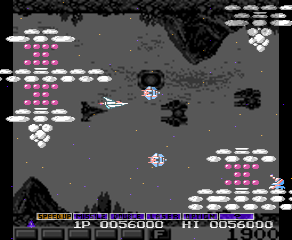 Here is a composite shot of all the upgrades selected at the same time.
Here is a composite shot of all the upgrades selected at the same time.
You destroy enemy ships that will have been predetermined to leave behind an upgrade that you then pick up. Gradius had enemies carrying upgrades coloured in orange. Here, the more you play, the more you know what to shoot down for upgrades because you have no way to tell beforehand if enemies will leave upgrades or not. Anyway, each upgrade you gather moves you one step forward in the weapon bar. So if you want the lasers, you need to gather four upgrades and then press the B button.
It’s the same system and upgrades as Gradius with one little notable exception: the first upgrade. The speed upgrade has a maximum of three levels to spend on. Gradius on NES allowed you to mess up royally: you could put too much upgrades into speed which made you go way too fast to conveniently manage your ship. Nowadays this means that Tool-Assisted Speedruns of Gradius are really interesting to watch, but to a human player it means a quick death because you run into a wall. To top it off, you could also spend upgrades on speed even if it brought you no more improvements. In Nemesis they fixed both problems; the third speed upgrade is the last one and is indeed harder to manage than the previous speed levels. It might be too fast for the average player, which meant you still had to take a meaningful decision regarding your speed: do you go for the third level and hone your reflexes or do you stay at the comfortable second speed level? To me this really feels like a developper who thought things through.
One thing that’s peculiar about Nemesis is the lack of persistent progress within every level. You know how in some shooters when you blow up your ship a new one immediately pops back up, never stopping the game or pushing you back to a previous point in the game? Nemesis doesn’t do that. Each of the game’s five levels has one checkpoint around the middle where you can restart if you die after passing it. Life Force on NES, Gradius’ console sequel, restarted you in the same spot where you died, making the game much more manageable. Gradius used a lot of discrete checkpoints. In Nemesis, this lack of persistence means that every level becomes a kind of puzzle. You ask yourself: how do I get as many upgrades as quickly as possible, and when do I spend them to efficiently finish this section? You’re trying your hardest to master the game as quickly as possible because you don’t want to suffer its punishing restart checkpoints. It’s actually fascinating how a simple thing as what happens when you die changes the whole game.
So far everything is not perfect but still the game is very good. However, on the column of crimes against humanity committed by Nemesis, there’s the sound the laser upgrade makes.
This horrible shrieking noise is constantly heard if you choose to get the most powerful weapon in the game. As a sound effect that you would hear when you die, or blow up a boss I guess it would be okay. Not hearing it every goddamn second! There were honestly times I chose the spread shot because I was tired of hearing the laser’s whine.
On the column of crazy-pants oversight, the game cartridge’s cover art features the Game Boy word mark on the side. So instead of using the full space available on the cartridge to display the picture on the box cover, they show the whole game cover, with the Game Boy logo. All early Konami titles do that. I collect Game Boy games for those crazy little details; they’re neat.
I collect Game Boy games for those crazy little details; they’re neat.
Konami GB Collection Volume I
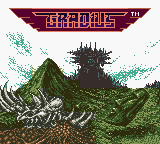
Konami put a new coat of paint on Nemesis and rereleased it in 1998–1999 in Japan with a cool project called the GB Collection. In Japan, the GB Collection were four games included together in one cartridge with added Super Game Boy support. Four volumes were released, for a total of 16 games receiving a Super Game Boy-specific palette. They are another proof that Konami understood the Game Boy market better than anyone.
The GB Collection was ultimately released in Europe in 2000, making them the only English-language versions of this collection we have, since they were released in no other territory. The European versions received Game Boy Color palettes while dropping Super Game Boy support. I previously said that Zelda DX will get its own article. The questions must then be asked: Are the versions of Nemesis on the two GB Collection versions essential in their own right? I don’t think so. They’re neat to try and look at, but they’re not different enough to warrant their own article, like The Legend of Zelda: Link’s Awakening DX. I have not dug too deep into their differences, but I immediately saw that there were some significant changes: the death screen has a different text and the weapons bar took the whole bottom of the screen. The score has been pushed to being visible only when you die.
To me, a lot of recoloured versions of Game Boy games have garish colours that don’t fit with the art style of the game. It’s the case for the GB Collection’s titles, but it’s nowhere near a deal breaker for the whole project. It merely means to me that the GB Collection versions of the games in those four volumes are interesting side notes, and that you can safely play either version and get an enjoyable experience.
Conclusion
It does not feel like Nemesis simplifies the concept of a shooter for the Game Boy (don’t mistake me, however, it does). It succeeds, through many little tricks, in presenting an experience that feels like playing the action-packed Gradius on NES. When Nemesis came out, most of the other developers for Game Boy were busy making slow-going character-based puzzle games. Konami showed them what a truly great developer they were.
This article was first published on the .
This article was last modified on the .